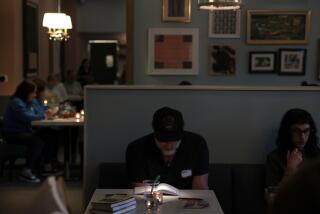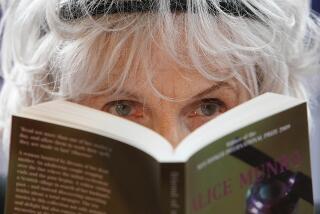A Vocal Supporter : Telling a Story Beats Reading a Book, Educator Says
- Share via
DENVER — Norma Livo tells stories--lots of stories. She tells them professionally on the stages of theaters and in libraries, schools, churches, parks and nursing homes.
She teaches others to tell them, too. Livo is a professor of education at the University of Colorado, Denver, and the innovative courses she began to launch in 1976 for graduate students in education include one in storytelling.
“As our society becomes more and more technologically advanced, we are bombarded on all sides by instant communication overload. I think people need that human touch,” Livo says.
Comfortably ensconced in her office overlooking the campus, she describes how storytelling brings people together, and how stories reflect the history, needs and values of the society from which they come.
“There is an immediate connection between storyteller and audience member in a way denied to most other art forms,” she says. The storyteller and listener make up the story together, in a sense, because the listener supplies the images evoked by the teller.
Livo grew up in Appalachia with a Scotch-Irish father and a Pennsylvania Dutch mother. She heard stories from both sides of the family--vastly different in content and style.
“Mother’s stories were folklorish kinds of things and they always had a moral to them: ‘If you do this, this will happen.’ Then from my father’s side they were full of the blarney, leg-pullers, tall tales, music and ballads full of mischief. My mother played the piano and the mandolin and my father played the fiddle, so no matter what side of the family got together, music and storytelling were important.”
Livo later married and had four children. One of her boys had a learning disability that teachers would not or could not deal with. So Livo went back to school to learn how to help her son. She encouraged him to tell stories, then wrote them down and made books out of them. She did this for all the children, all of whom were good storytellers, so that her special-needs child would not feel different. She taught him to read when schoolteachers could not.
While still working on her doctorate, Livo became the director of a summer reading workshop for children four grade levels behind their peers. During that eight-week period, she watched an art teacher raise the reading scores of her students while the reading teachers’ students lagged. The art teacher allowed the children to research, read, and write about subjects that interested them. Her students built models, taped interviews and wrote stories.
“This convinced me there is more to education than we were putting into it,” Livo recalls. Listening, speaking, reading and writing all mesh when teaching children, she realized.
After earning her doctorate, Livo immediately began to put into place new courses that integrate the arts into education. Storytelling figures prominently in her classroom and eventually in her students’ classrooms.
“You can teach history, science, math, anything you want with a story and make it dramatic and unforgettable,” Livo explains.
“A friend of mine who is a young black storyteller in New Hampshire told me about telling stories in a third-grade class. A kid came up to him afterward and said, ‘You told that same story last year.’ Len Cabrel said, ‘No, I didn’t, I’ve never been in this school before.’ And the child said, ‘Yes you were, but you were white then.’ The child remembered the story. That is the power of story.”
Livo likes to point to the oral traditions of other societies as she discusses the richness of oral culture. She unfurls a magnificently embroidered cloth called a pa ndau, or flower cloth, made by Hmong refugees from Vietnam.
“These beautiful pieces of art are ways of preserving their stories and their history and passing them on,” she says. “Not only do they tell the stories of how things used to be, but they also depict scenes from the war and resettlement camps and life in the United States. Pa ndaus may have images of TV sets or rock bands or refrigerators. The flower cloths are one way the Hmong had and still have to make money in the resettlement camps.”
Livo has collected many stories from Hmong living in Colorado. Their oral tradition is very “thick,” she says. They had no written language until missionaries introduced it in the 1950s.
Livo points out that the arts are used in a variety of ways to share a people’s stories--whether personal, communal or traditional. Stories also help us to understand a people’s culture, values, hopes and fears.
In addition to her teaching, performing and writing, Livo organizes annual conferences in celebration of oral storytelling traditions. The theme for the next conference, in March, is multicultural tale-spinning. She also has helped develop a yearly tour of storytellers who visit communities all over Colorado under the auspices of the Colorado Council on the Arts and Humanities.
“Norma Livo is truly the grande dame of storytelling in the Rocky Mountain region,” says Jimmy Neil Smith, executive director of the National Assn. for the Preservation and Perpetuation of Storytelling.
“We’re very excited to have elected her to the board of directors of NAPPS because she will bring such a wealth of understanding to the work. Her writings about storytelling in education are among the most important and the most used in colleges and universities around the country.” (Livo, with Sandra A. Reitz, wrote “Storytelling: Process and Practice,” published in 1986 by Libraries Unlimited Inc. of Englewood, Colo.) “She is truly a pioneer in the storytelling revival that is going on right now,” he adds.
The revival of which Smith speaks amounts to a renaissance, he and Livo agree.
NAPPS numbers more than 4,000 members and draws thousands more to its National Storytelling Institute each year.
“It’s an art form that is very old and is being rediscovered,” Smith says. “In 1973, when NAPPS began, there were only a dozen people who called themselves storytellers.
“Now there are between 300 and 400 who are professional, full-time storytellers, and many thousands more who actively use storytelling in their professions in the classroom, the pulpit, the library and the boardroom.”
More to Read
Sign up for our Book Club newsletter
Get the latest news, events and more from the Los Angeles Times Book Club, and help us get L.A. reading and talking.
You may occasionally receive promotional content from the Los Angeles Times.










